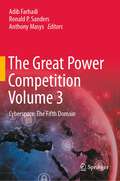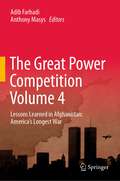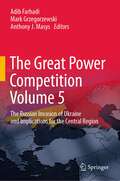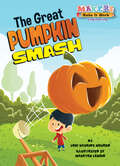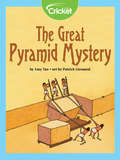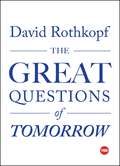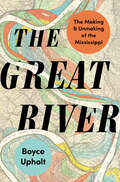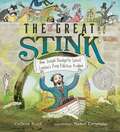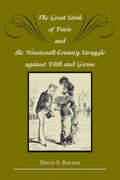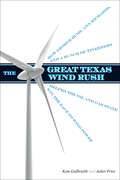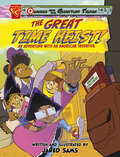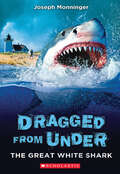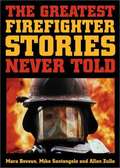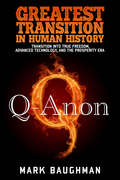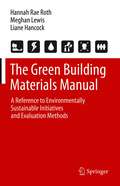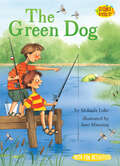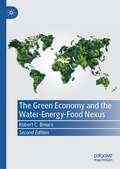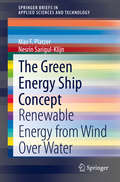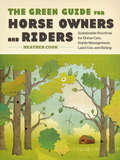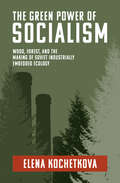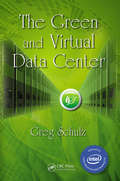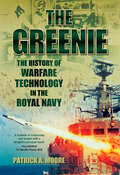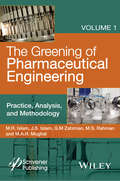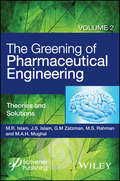- Table View
- List View
The Great Power Competition Volume 3: Cyberspace: The Fifth Domain
by Ronald P. Sanders Anthony Masys Adib FarhadiFor millennia, humans waged war on land and sea. The 20th century opened the skies and the stars, introducing air and space as warfare domains. Now, the 21st century has revealed perhaps the most insidious domain of all: cyberspace, the fifth domain. A realm free of physical boundaries, cyberspace lies at the intersection of technology and psychology, where one cannot see one’s enemy, and the most potent weapon is information.The third book in the Great Power Competition series, Cyberspace: The Fifth Domain, explores the emergence of cyberspace as a vector for espionage, sabotage, crime, and war. It examines how cyberspace rapidly evolved from a novelty to a weapon capable of influencing global economics and overthrowing regimes, wielded by nation-states and religious ideologies to stunning effect.Cyberspace: The Fifth Domain offers a candid look at the United States’ role in cyberspace, offering realistic prescriptions for responding to international cyber threats on the tactical, strategic, and doctrinal levels, answering the questions of how can we respond to these threats versus how should we respond? What are the obstacles to and consequences of strategic and tactical response options? What technological solutions are on the horizon? Should the U.S. adopt a more multi-domain offensive posture that eschews the dominant “cyber vs. cyber” paradigm? To answer these questions, experts examine the technological threats to critical infrastructure; cyber operations strategy, tactics, and doctrine; information influence operations; the weaponization of social media; and much more.
The Great Power Competition Volume 4: Lessons Learned in Afghanistan: America’s Longest War
by Anthony Masys Adib FarhadiLessons Learned from Afghanistan: America’s Longest War examines the lessons of how America’s “longest war” came to an ignominious end with staggering consequences for the United States and the Afghan nation. Afghanistan today faces an unprecedented humanitarian crisis, looming threat of a civil war and a resurgence of violent extremism organizations similar to pre-9/11. As the U.S. enters a new era in the strategic geopolitical Great Power Competition, an analysis of the original mission intent, shifting policy and strategic objectives, and ineffective implementation of security, political and economic programs reveal critical lessons and questions such as: What led to the “strategic failure” of the U.S. in Afghanistan? What decisions resulted in the present-day humanitarian, civil, and political crises in Afghanistan? Were these consequences in fact avoidable? Was there an alternative approach that could have maintained the hard-fought gains of the last two decades, and better demonstrated America's standing as a defender of global human rights? Lessons Learned from Afghanistan: America’s Longest War further explores lessons of the past negotiations between the United States, Taliban, and former U.S. backed Afghan government to suggest alternative pathways that honor the original intent of the mission and meet present-day obligations to an Afghan nation in crisis.
The Great Power Competition Volume 5: The Russian Invasion of Ukraine and Implications for the Central Region
by Anthony J. Masys Adib Farhadi Mark GrzegorzewskiThe Russian Invasion of Ukraine and Implications for the Central Region addresses national security threats and strategic opportunities for the United States and its allies in the Middle East and Central Asia following Russia’s invasion of Ukraine. Recognizing that integrated deterrence is not constrained by geography or domain, this book focuses on the complex threats and challenges confronting U.S. national security and foreign policy in a post-Ukraine invasion environment. That is to say, what happens in Ukraine does not stay in Ukraine. It affects everyone from the region to the cyberspace domain to people on the other side of the world, due to changes in commodity prices.Specifically, this volume explores how revised analyses of Russia may alter U.S. and allied strategies in a shifting international system and within the framing of strategic competition. Experts in this volume examine how the war in Ukraine will influence Russian strategy and foreign policy in the Middle East, Central Asia, and globally; what effect the Ukraine invasion could have on global and regional geopolitics and geoeconomics; and the United States’ ability to protect national interests in the Central Region. The reasons for this are multiple and complex. In this volume, we explore many issues that have confounded security experts by asking questions such as: What happens after the Russian invasion? What lessons did the U.S., Ukraine, NATO, and the European Union learn about Russia? What lessons did Russia learn about itself and its military after the Ukraine invasion? What lessons did the U.S. learn in Afghanistan that apply to Ukraine? Why was the initial analysis of the Russian invasion so wrong? How has power shifted in the international system since the Ukraine invasion? How has the security environment shifted since the Ukraine invasion? For the U.S. to continue supporting its partners in the Middle East and Central Asia, it must anticipate what new opportunities will arise from Russia’s missteps in Ukraine. The Russian Invasion of Ukraine and Implications for the Central Region addresses these challenges and opportunities and informs policymakers on the changing contours of the Great Power Competition.
The Great Pumpkin Smash (Makers Make It Work)
by Lori Haskins HouranFor Luke, autumn in Florida feels weird. There are no changing leaves, no cider, and worst of all, no pumpkin chucking! But maybe he can engineer a way to bring pumpkin spice to the south. Tying into the popular Makers Movement, Makers Make It Work is a series of fun easy-to-read stories that focus on problem-solving and hands-on action. This charming story explores the Makers theme of Engineering and includes explanatory sidebars and a catapult activity for young makers to try themselves!
The Great Pyramid Mystery
by Amy TaoNo one knows for sure just how the ancient Egyptians built the Great Pyramid of Giza, which is taller than the Statue of Liberty. How could an ancient civilization have achieved this engineering feat? Perhaps the solution to this mystery can be answered with simple machines!
The Great Questions of Tomorrow: The Ideas That Will Remake The World (TED Books)
by David RothkopfA unique tour around the world in search of the great thinkers of our time and their next big ideas.We are on the cusp of a sweeping revolution—one that will change every facet of our lives. The changes ahead will challenge and alter fundamental concepts such as national identity, human rights, money, and markets. In this pivotal, complicated moment, what are the great questions we need to ask to navigate our way forward? David Rothkopf believes in the power of questions. When sweeping changes have occurred in history—the religious awakenings of the Reformation; the scientific advances of the Age of Exploration; the technological developments of the Renaissance, the Enlightenment, and the Industrial Revolution—they have brought with them, not just new knowledge, but provoked great questions about how we must live. With the world at the threshold of profound change, Rothkopf seeks the important questions of our time—ones that will remake the world and our understanding of it. From the foundational questions: "Why do we live within a society?" and "What is war?" to modern concerns such as "Is access to the internet a basic human right?" The Great Questions of Tomorrow confronts our approach to the future and forces us to reimagine fundamental aspects of our lives—identity, economics, technology, government, war, and peace.
The Great River: The Making and Unmaking of the Mississippi
by Boyce UpholtA sweeping history of the Mississippi River—and the centuries of human meddling that have transformed both it and America. The Mississippi River lies at the heart of America, an undeniable life force that is intertwined with the nation’s culture and history. Its watershed spans almost half the country, Mark Twain’s travels on the river inspired our first national literature, and jazz and blues were born in its floodplains and carried upstream. In this landmark work of natural history, Boyce Upholt tells the epic story of this wild and unruly river, and the centuries of efforts to control it. Over thousands of years, the Mississippi watershed was home to millions of Indigenous people who regarded “the great river” with awe and respect, adorning its banks with astonishing spiritual earthworks. The river was ever-changing, and Indigenous tribes embraced and even depended on its regular flooding. But the expanse of the watershed and the rich soils of its floodplain lured European settlers and American pioneers, who had a different vision: the river was a foe to conquer. Centuries of human attempts to own, contain, and rework the Mississippi River, from Thomas Jefferson’s expansionist land hunger through today’s era of environmental concern, have now transformed its landscape. Upholt reveals how an ambitious and sometimes contentious program of engineering—government-built levees, jetties, dikes, and dams—has not only damaged once-vibrant ecosystems but may not work much longer. Carrying readers along the river’s last remaining backchannels, he explores how scientists are now hoping to restore what has been lost. Rich and powerful, The Great River delivers a startling account of what happens when we try to fight against nature instead of acknowledging and embracing its power—a lesson that is all too relevant in our rapidly changing world.
The Great Stink How Joseph Bazalgette Solved London's Poop Pollution Problem: How Joseph Bazalgette Solved London's Poop Pollution Problem
by Colleen PaeffIt's the summer of 1858, and London's River Thames STINKS. What is creating this revolting smell? The answer is gross: the river is full of poop. But the smell isn't the worst problem. Every few years, cholera breaks out, and thousands of people die. Could there be a connection between the foul water and the deadly disease? One engineer dreams of making London a cleaner, healthier place. His name is Joseph Bazalgette. His grand plan to create a new sewer system to clean the river is an engineering marvel. And his sewers will save lives. Nothing stinky about that.
The Great Stink of Paris and the Nineteenth-Century Struggle against Filth and Germs
by David S. BarnesExplores the scientific and social factors that continue to influence the public's lingering uncertainty over how disease can—and cannot—be spread.Late in the summer of 1880, a wave of odors enveloped large portions of Paris. As the stench lingered, outraged residents feared that the foul air would breed an epidemic. Fifteen years later—when the City of Light was in the grips of another Great Stink—the public conversation about health and disease had changed dramatically. Parisians held their noses and protested, but this time few feared that the odors would spread disease. Historian David S. Barnes examines the birth of a new microbe-centered science of public health during the 1880s and 1890s, when the germ theory of disease burst into public consciousness. Tracing a series of developments in French science, medicine, politics, and culture, Barnes reveals how the science and practice of public health changed during the heyday of the Bacteriological Revolution.Despite its many innovations, however, the new science of germs did not entirely sweep away the older "sanitarian" view of public health. The longstanding conviction that disease could be traced to filthy people, places, and substances remained strong, even as it was translated into the language of bacteriology. Ultimately, the attitudes of physicians and the French public were shaped by political struggles between republicans and the clergy, by aggressive efforts to educate and "civilize" the peasantry, and by long-term shifts in the public's ability to tolerate the odor of bodily substances.
The Great Texas Wind Rush: How George Bush, Ann Richards, and a Bunch of Tinkerers Helped the Oil and Gas State Win the Race to Wind Power
by Kate Galbraith Asher PriceFrom two environmental journalists, &“the improbable story of how the oil and gas state became the nation&’s wind-power leader&” (The Texas Observer). In the late 1990s, West Texas was full of rundown towns and pumpjacks, aging reminders of the oil rush of an earlier era. Today, the towns are thriving as 300-foot-tall wind turbines tower above those pumpjacks. Wind energy has become Texas&’s latest boom. How did this dramatic transformation happen in a state that fights federal environmental policies at every turn? In The Great Texas Wind Rush, environmental reporters Kate Galbraith and Asher Price tell the compelling story of a group of unlikely dreamers and innovators, politicos and profiteers. The tale spans a generation and more, and it begins with the early wind pioneers, precocious idealists who saw opportunity after the 1970s oil crisis. Operating in an economy accustomed to exploiting natural resources and always looking for the next big thing, their ideas eventually led to surprising partnerships between entrepreneurs and environmentalists, as everyone from Enron executives to T. Boone Pickens, as well as Ann Richards, George W. Bush and Rick Perry, ended up backing the new technology. In this down-to-earth account, the authors explain the policies and science that propelled the &“windcatters&” to reap the great harvest of Texas wind. They also explore what the future holds for this relentless resource that is changing the face of Texas energy. &“Enjoyable to read. . . . I learned something on every page.&” —Michael Webber, Associate Director, Center for International Energy and Environmental Policy, University of Texas at Austin &“A thoughtful, valuable story for anyone who cares about renewable energy or climate change.&” ―The Associated Press
The Great Time Heist!: An Adventure with an American Inventor (Qianna and the Quantum Train)
by Jared SamsQianna is suffering the worst thing an inventor can experience—inventor's block! With the school science fair coming up, she'll do anything to defeat her rival, Maddy. That includes taking the Quantum Train back in time to “borrow” George Washington Carver's bag of ideas. Can two young inventors of color see eye-to-eye on how to use their science smarts? Find out in a dynamic graphic novel that gives science, engineering, and invention a hip-hop spin!
The Great White Shark (Dragged from Under #2)
by Joseph MonningerDANGER FROM THE DEPTHS!In beautiful Cape Cod, a fatal Great White attack rocks the popular tourist destination. As the beaches are closed and locals grow angry, a recently arrived Barn Whimbril heads straight into the action. But with a group of local teens determined to surf no matter what or who gets in the way, can Barn safely investigate the attack or will he come face-to-face with the ocean's most feared apex predator?
The Greatest Firefighter Stories Never Told
by Allan Zullo Mara Bovsun Mike SantangeloThe firefighters who lost their lives in the September 11 attack on the World Trade Center have become well-known-and rightfully so. But firefighters throughout America risk life and limb every day, many times without any acknowledgement whatsoever, let alone fame or fortune. In The Greatest Firefighter Stories Never Told, authors Mike Santangelo, Mara Bovsun and Allan Zullo have collected more than two dozen gripping accounts of America's bravest heroes, those who save lives every day as they rush in to rescue others. From airport firefighters to hazardous materials experts, from forest firefighters to high-elevation rescuers, from smoke jumpers to harbor firefighters, The Greatest Firefighter Stories Never Told captivates readers with its focus on the fresh and fascinating tales of real heroes and those they save. Several stories highlight some of the courageous firefighters of the New York Fire Department who were on hand during the terrorist attacks on the World Trade Center. Already, the department's heroism has captured America's heart. These gripping, in-depth stories will put names and faces to those most deserving of worldwide recognition.
The Greatest Transition In Human History: Transition into True Freedom, Advanced Technology, and The Prosperity Era
by Mark BaughmanKnowledge is power. Real truth is freedom. Freedom is what our Founding Fathers wanted to create as the beacon of light to the world in 1776. America was to be the example of what humanity could be. Was that really achieved? The Greatest Transition in Human History tells the real story of America over the past over 200 years - the heartbreak, false-flag wars, hidden technology, power, corruption, and manipulation. Does the American citizen have real Freedom as the great Constitution and Bill of Rights intended? The Greatest Transition in Human History is the real emotion story of great Americans and patriots standing up for these great rights. These freedoms were taken for granted by so many - for many fell asleep and did not participate as much as we should have, including myself for many years. No more, for I work for humanity, and freedom. I want that real Freedom Bell to ring for all. For in the oath to a military person sworn in to our armed forces, they are to fight any enemy both foreign and domestic. The Greatest Transition in Human History is the story of brave people standing up for individual freedoms and rights worldwide, in the Greatest Secret War ever.
The Greeks and the New
by Armand D'AngourThe Greeks have long been regarded as innovators across a wide range of fields in literature, culture, philosophy, politics and science. However, little attention has been paid to how they thought and felt about novelty and innovation itself, and to relating this to the forces of traditionalism and conservatism which were also present across all the various societies within ancient Greece. What inspired the Greeks to embark on their unique and enduring innovations? How did they think and feel about the new? This book represents the first serious attempt to address these issues, and deals with the phenomenon across all periods and areas of classical Greek history and thought. Each chapter concentrates on a different area of culture or thought, while the book as a whole argues that much of the impulse towards innovation came from the life of the polis which provided its setting.
The Green Building Materials Manual: A Reference to Environmentally Sustainable Initiatives and Evaluation Methods
by Hannah Rae Roth Meghan Lewis Liane HancockEvaluating building materials for environmental sustainability is a complex prospect. How do governmental agencies and the design industry actually measure sustainable initiatives and environmental impacts? This book breaks down the technical vocabulary and principles that define environmentally sustainable choices across interior and exterior architectural products to help the reader understand: Material ingredient selectionEnergy and water useEmissions, including greenhouse gasesHuman health and toxicitySocial accountability assessment This guide explains the structure of green certifications, standards and ecolabels, life cycle assessment, environmental regulations, and more. It presents a historic timeline for context and a snapshot of current trends and future objectives. It is a comprehensive reference for interior designers, architects, building owners, contractors, and students enrolled in interior design and architecture.
The Green Dog (Science Solves It!)
by Melinda LukeWhat made the dog turn green? And why is the water in the pool green? Will teddy save his pet-sitting business?
The Green Economy and the Water-Energy-Food Nexus
by Robert C. BrearsThis book argues that a variety of policies will be required to create synergies between the water-energy-food nexus sectors while reducing trade-offs in the development of a green economy. Despite rising demand for water, energy and food globally, the governance of water-energy-food sectors has generally remained separate with limited attention placed on the interactions that exist between them. Brears provides readers with a series of in-depth case studies of leading cities, states, nations and regions of differing climates, lifestyles and income-levels from around the world that have implemented a variety of policy innovations to reduce water-energy-food nexus pressures and achieve green growth. The Green Economy and the Water-Energy-Food Nexus will be of interest to town and regional planners, resource conservation managers, policymakers, international companies and organisations interested in reducing water-energy-food nexus pressures, environmental NGOs, researchers, graduate and undergraduate students.
The Green Energy Ship Concept: Renewable Energy from Wind Over Water (SpringerBriefs in Applied Sciences and Technology)
by Max F. Platzer Nesrin Sarigul-KlijnThis groundbreaking book aims to show that technology currently exists to build and operate large autonomous sailing ships equipped with hydrokinetic turbines and electrolysers that could operate in high-wind ocean areas. This technology would enable seawater to be converted into storable hydrogen, thereby tapping into an inexhaustible energy reservoir sufficient for the transition to an emission-free global economy. The book is presented in two parts. Part one presents a broad look at possible solutions to the climate change challenge and provides an overview of current approaches. Part two introduces 12 specific technologies that could enable the green energy ship concept.
The Green Guide for Horse Owners and Riders: Sustainable Practices for Horse Care, Stable Management, Land Use, and Riding (Green Guide Ser.)
by Heather CookReduce your carbon hoofprint! Covering everything from environmentally sensitive trail riding to building a green barn, this guide is packed with simple, practical ways to create a healthy, chemical free, and sustainable environment for you and your horses. Heather Cook provides strategies for collecting rainwater, finding locally sourced feed, using natural cleaning products, and much more. Whether you keep a barn full of horses or rent a stall for just one, you&’ll find dozens of suggestions for implementing practices that preserve land, water, and energy.
The Green Power of Socialism: Wood, Forest, and the Making of Soviet Industrially Embedded Ecology (History for a Sustainable Future)
by Elena KochetkovaHow the Soviet forestry industry developed a unique form of industrial ecology—a commonsense approach toward natural resources for the economy and society.In The Green Power of Socialism, Elena Kochetkova examines the relationship between nature and humans under state socialism by looking at the industrial role of Soviet forests. The book explores evolving Soviet policies of wood consumption, discussing how professionals working in the forestry industry of the Soviet state viewed the present and future of forests by considering them both a natural resource and a trove of industrial material. When faced with the prospect of wood shortages, these specialists came to develop new industry-ecology paradigms. Kochetkova looks at the materiality of Soviet industry through forests and wood to show how, paradoxically, industrial ecology emerged and developed as a by-product of the Soviet industrialization project.The Green Power of Socialism also discusses how post-Soviet industry has abandoned these socialist practices and the idea of nature as a complicated ecosystem that provides a crucial service to society. Emphasizing the technological and environmental impacts of the Cold War, Kochetkova critically reconsiders two explanatory models that have become dominant in the historiography of Soviet approaches to nature over the last decades—ecocide and environmentalism. Within the context of the current environmental crisis, the book invites readers to reevaluate state socialism as a complex phenomenon with sophisticated interactions between nature and industry. In so doing, it contributes a fresh perspective on the activities of socialist experts and their view of nature, shedding light on Soviet state industrial and environmental policy and its continuing legacy in the present day.
The Green and Virtual Data Center
by Greg SchulzThe Green and Virtual Data Center sets aside the political aspects of what is or is not considered green to instead focus on the opportunities for organizations that want to sustain environmentally-friendly economical growth. If you are willing to believe that IT infrastructure resources deployed in a highly virtualized manner can be combined with other technologies to achieve simplified and cost-effective delivery of services in a green, profitable manner, this book is for you. Savvy industry veteran Greg Schulz provides real-world insight, addressing best practices, server, software, storage, networking, and facilities issues concerning any current or next-generation virtual data center that relies on underlying physical infrastructures. Coverage includes: Energy and data footprint reduction, Cloud-based storage and computing, Intelligent and adaptive power management, Server, storage, and networking virtualization, Tiered servers and storage, network, and data centers, Energy avoidance and energy efficiency. Many current and emerging technologies can enable a green and efficient virtual data center to support and sustain business growth with a reasonable return on investment. This book presents virtually all critical IT technologies and techniques to discuss the interdependencies that need to be supported to enable a dynamic, energy-efficient, economical, and environmentally-friendly green IT data center. This is a path that every organization must ultimately follow. Take a tour of the Green and Virtual Data Center website. CRC Press is pleased to announce that The Green and Virtual Data Center has been added to Intel Corporation's Recommended Reading List. Intel's Recommended Reading program provides technical professionals a simple and handy reference list of what to read to stay abreast of new technologies. Dozens of industry technologists, corporate fellows, and engineers have helped by suggesting books and reviewing the list. This is the most comprehensive reading list available for professional computer developers.
The Greenie: The History of Warfare Technology in the Royal Navy
by Patrick A MooreIn the Royal Navy vernacular, the term 'greenie' describes the officers and ratings responsible for the electrical engineering functions of the fleet. Electrical engineering has 'driven' the Royal Navy for far longer than one might imagine, from solving the problem of magnetic interference with the compass by the ironclad early in the 20th century onward. Author Commander Moore traces the development of technology from 1850 to today's integrated micro computers that control almost every aspect of navigation, intel, and strike capacity. At the same time, he describes how the Navy's structure and manpower changed to accommodate the new technologies, changes often accelerated in wartime, particularly in World War II. Without the full cooperation of naval establishments and organisations and various public and private museums and manufacturers, this work would have been impossible to produce. Written in an anecdotal, narrative style but with a complete mastery of the science itself, it will appeal not only to those interested in the history of the Royal Navy but also those many thousands, past and present, who can claim the honour of calling themselves one of the Greenies.
The Greening of Pharmaceutical Engineering
by Gary M. Zatzman Jaan S. Islam M. R. Islam M. A. Mughal M. Safiur RahmanThe pharmaceutical industry is one of the most important industries in the world, offering new medicines, vaccines, and cures to a global population. It is a massive industry, worthy of a deep and thorough examination of its processes and chemistry, with a view toward sustainability. The authors describe what is and isn't truly sustainable, offering a new approach and a new definition of the sustainability of pharmaceutical and chemical engineering and the science behind it. This is a cutting-edge work, aimed at engineers, scientists, researchers, chemists, and students.
The Greening of Pharmaceutical Engineering, Theories and Solutions
by Gary M. Zatzman Jaan S. Islam M. R. Islam M. A. Mughal M. Safiur RahmanThis is the second volume in a four-volume series aimed at guiding the pharmaceutical industry toward sustainability. After analyzing and exposing some of the backward and ill-conceived notions that guide the present state of the industry, this volume presents key theories and new, groundbreaking solutions for re-thinking the processes involved in the engineering of pharmaceuticals and offers a fundamental paradigm shift.The 4 volumes in this ambitious project are: * Volume 1: Practice, Analysis, and Methodology * Volume 2: Theories and Solutions * Volume 3: Applications for Mental Disorder Treatments * Volume 4: Applications for Physical Disorder TreatmentsThis ground-breaking set of books is a unique and state-of-the-art study that only appears here, within these pages. A fascinating study for the engineer, scientist, and pharmacist working in the pharmaceutical industry and interested in sustainability, it is also a valuable textbook for students and faculty studying these subjects.
